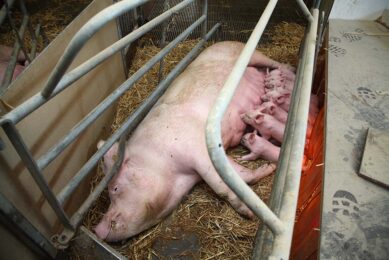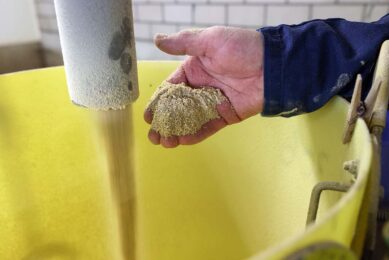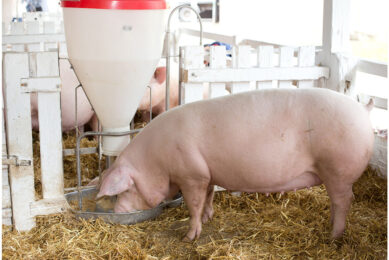Interventions to better deal with IUGR piglets

With ever-growing litter sizes, chances increase that some piglets are born with intra-uterine growth retardation (IUGR). The topic has been studied extensively in recent years. How is the phenomenon defined and – more importantly – what can be done to best treat these piglets?
One of the greatest challenges raised by the introduction of hyperprolific sows has been the associated increase in piglet mortality and morbidity. It has been known for many years that piglet stillbirth and pre-weaning mortality increase with litter size. The introduction of prolific sow lines, with litter sizes now averaging more than 16 in some countries, has worsened that problem, which has been alleviated only by concurrent selection for piglet survival traits. Figure 1 shows the relationship between litter size and piglet survival obtained in a recent UK study.
Intra-uterine growth retardation (IUGR)
The reasons for this association between litter size and piglet mortality encompass a number of factors, including a prolongation of farrowing and associated hypoxia in the offspring and increased competition for teat access and nutrients. The most fundamental problem predisposing increased mortality in litters of hyperprolific sows has been reduced viability of newborn piglets due to intra-uterine growth retardation (IUGR). There have been many reviews of the aetiology and underlying mechanisms of IUGR, which results from deficiencies in both embryo quality and uterine capacity.

Birth weight and IUGR determination
First of all, methods for identification of IUGR piglets include various birth weight categorisations. Secondly, IUGR is associated with a long and thin body shape, which can be quantified, as in human neonates, by low ponderal index (PI) or body mass index (BMI). Perhaps the clearest external sign of IUGR relates to head morphology. When foetal nutrient supply is limited, relatively more nutrients are directed toward growth of the brain (brain sparing) and heart as part of a foetal adaptive reaction to placental insufficiency. Recent studies have characterised IUGR based on 3 criteria:
- steep, dolphin-like forehead
- bulging eyes
- wrinkles perpendicular to the mouth.
A classification of severe (s-IUGR) is given if 2 or 3 of the characteristics are present, and of moderate (m-IUGR) if only one of the characteristics is present. While IUGR piglets are typically smaller than their littermates, these head shape characteristics can be seen in pigs across the birth weight range (see Figure 2).

Challenges for IUGR piglets
Some of the survival challenges experienced by IUGR piglets relate specifically to their smaller size. Low birth weight piglets display a lower vitality, and are less resistant to cold because of their greater surface area to volume ratio. When born wet with foetal fluids, into an environment where the temperature is typically 10–20 degrees less than core body temperature, they rapidly lose heat. Since they are born with very limited energy reserves, this negative energy balance can only persist for a short time before becoming fatal. The problem is even greater for low birth weight piglets competing in a litter with larger siblings.
Reduced maturity at birth
Piglets that show IUGR characteristics in their weight or morphology also show other differences which indicate reduced maturity at birth. Brains from low birth weight foetuses are less myelinated and have less dendritic development than the brains from normally grown littermates. That might contribute to the tendency towards a lower vitality score in s-IUGR piglets. Furthermore, low birth weight pigs show compromised muscle, cardiac and renal physiology.
Digestive organs also affected
Digestive organs are also affected by IUGR. In low birth weight piglets, the relative weight of the pancreas is reduced, and IUGR is associated with a reduction in the wall thickness of the stomach, small intestine and colon. The intestinal surface area for absorption is highly reduced, with the average number of villi per unit area and the height of villi being 15% to 20% lower.
Hormonal status
Hormonal status, at birth and subsequently, is also affected by IUGR. However, the mechanisms by which these permanent effects occur and the interrelation between hormones remain unclear.
Consequences of IUGR
The most obvious consequence of IUGR is the increased mortality of afflicted piglets during the neonatal period. The relationship between birth weight and survival is well established. Pre-weaning survival rates decreased progressively from 95% to 15% as piglet birth weight decreased from 1.80kg to 0.61kg. In addition, low birth weight piglets that survive show consistently lower postnatal growth rates. Long-term effects on piglet welfare have received insufficient study to date.
Genetic selection against IUGR
One approach to reducing the problem of IUGR piglets is to employ genetic selection against this characteristic.
Selection for birth weight
Piglet birth weight may be considered as more than a single trait depending on the level that is under investigation: individual piglet birth weight at the offspring level, or as litter traits at the dam level – average birth weight, within-litter birth weight variability, total litter weight.

Figure 3 shows the relationship between litter size and average piglet birth weight obtained in a recent UK study. As litter size increased, the average birth weight decreased and the proportion of IUGR piglets (as determined by head shape) increased.
Selection against IUGR morphology
Selection for an increase in average birth weight or litter weight can be applied, but other traits relating to the IUGR phenotype should also be considered. IUGR-linked traits such as PI and BMI or cranial circumference, which are based on weighing or measuring individual piglets, are time consuming to record and not suitable for large-scale data collection on commercial breeding units. However, the proportion of piglets in a litter showing IUGR head morphology is a simple measure and does show a level of heritability which would allow it to be selected against in sows.
Aiding survival of IUGR piglets
A number of management interventions are required to promote the survival and welfare of low birth weight and IUGR piglets, and the extent to which these strategies are successful partly depends on the IUGR status of the piglet. Prompt humane euthanasia should also be recognised as an important management tool to prevent unnecessary suffering of pathologically growth-retarded piglets.

Supplementary heating
For all piglets, use of supplementary radiant heating at the birth site and adjacent to the udder, where piglets spend the early hours of postnatal life, will improve piglet survival. Low viability piglets which fail to suckle can show a reduction in body temperature of 4–5°C within the first 30 minutes of life (Figure 4).
While heated creep areas separate to the sow are regularly used in farrowing houses, piglets in the first 24–48 hours of life prefer to spend time at the udder, and vulnerable piglets may not survive this period. Provision of under-floor heating for 24 hours in the nest-area in loose-housed farrowing pens has improved survival, and deep-straw bedding has particularly effective insulating properties and is used effectively by outdoor and loose-housed indoor producers with demonstrable positive effects on piglet survival.
Ensuring colostrum intake
Even if the micro-climate can be optimised, there are finite windows within which piglets must ingest colostrum, not only to acquire the necessary immunoglobulins of which they are born naïve, but more urgently to thermoregulate and balance energy. Farrowing supervision promotes targeted inputs by stock people to assist piglets with important first-time landmark behaviours – getting quickly to the udder and suckling good quality colostrum.
Ingestion of the biological mother’s colostrum is thought to be optimal, but additional colostrum supplementation, when correctly administered, has been found to be effective in these at-risk populations.
Split suckling
Split suckling involves splitting the litter into two groups, often heaviest and lightest or strongest and weakest, and removing the more advantaged of these groups for a set period of time to allow uncompetitive suckling for those remaining at the udder. Implementing split suckling quickly after farrowing should allow all piglets access to colostrum and therefore acquisition of passive immunity.
Cross-fostering
Cross-fostering involves removing some or all piglets from their birth sow to a foster sow, or exchanging piglets between sows depending on their size, vigour and gender, as well as physical characteristics of the sow’s udder. If performed correctly, grouping small piglets on a suitable sow, cross-fostering gives piglets enhanced survival prospects and can reduce the need for further management interventions for piglets that would otherwise suffer from remaining in a large litter.
Artificial rearing systems
If the number of piglets born exceeds the number of available teats, nurse sow strategies can be used to accommodate the excess. Artificial rearing systems remove the need for nurse sows, which some farms find difficult to manage. Here, some of the stronger piglets are removed from their mothers at 2 to 14 days old and transferred to specialised enclosures which are typically located either in a separate room or above the sow’s farrowing crate (e.g. rescue decks). These enclosures provide the piglets with warmth, milk replacer and solid food. Such systems are being increasingly used in some countries to deal with surplus piglets, but require a high level of management to function successfully and are prohibited in other countries because of welfare concerns.
Significant economic and welfare problem
IUGR has become a significant economic and welfare problem in the modern industry and urgently needs to be addressed by all available methods.
To reduce the number of IUGR piglets born, genetic selection strategies for higher individual birth weight or reduced prevalence of piglets IUGR morphology can be employed. In addition, management strategies are still required to deal with these low viability piglets when they occur.
References available on request.

This article is an edited and approved version of a chapter in the book ‘Nutrition of Hyperprolific Sows’, published by Novus International, November 2019. A digital version of the book is available for free at http://www2.novusint.com/sow_book.
 Beheer
Beheer








 WP Admin
WP Admin  Bewerk bericht
Bewerk bericht